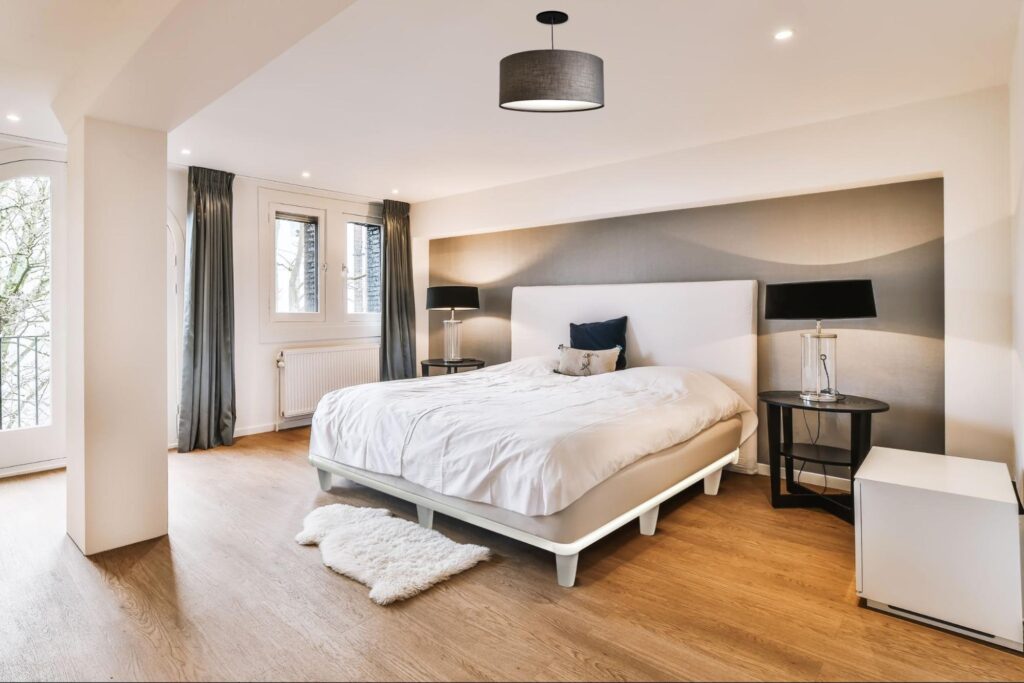For a long time, the idea of couples sleeping in separate beds seemed unusual. It carried a stigma, making people think the relationship was on rocky ground. But times are changing. More and more couples are prioritizing quality sleep, often opting for a no squeak bed frame that ensures peace and quiet, to get a better night’s sleep and improve their well-being.
On the other hand, many couples prefer to stay close at night. For them, sharing a bed is about intimacy and bonding, even if it means dealing with occasional challenges like motion transfer or noisy bed frames. For intimate couples especially, finding a no squeak bed frame can make all the difference in creating a peaceful and supportive sleep environment.
Why More Couples Are Sleeping in Separate Beds
A study by the National Sleep Foundation found that one in four couples sleep in separate beds. This trend has been growing for a variety of reasons. Some people can’t handle their partner’s snoring, while others have completely different schedules or preferences for mattress firmness. For these couples, sleeping separately can make a big difference in their quality of life.
Sleep isn’t just about rest. It’s when our bodies repair tissues, process memories, and regulate hormones. A good night’s sleep helps us feel refreshed, focused, and less stressed. But sharing a bed with someone can sometimes disrupt that process.
Dr. Wendy Troxel, a behavioral scientist and sleep expert, has studied how sharing a bed affects couples. Her research shows that while sharing a bed can boost intimacy, it can also lead to fragmented sleep. Partners often wake each other up without realizing it, whether through snoring, tossing and turning, or talking in their sleep.

Snoring is one of the biggest culprits. The American Academy of Sleep Medicine estimates that nearly 40 percent of men and 24 percent of women snore regularly. For the non-snoring partner, this can mean hours of interrupted sleep, leaving them groggy and irritable the next day.
Another problem is dealing with squeaky or sagging beds. Over time, mattresses can lose their support, causing discomfort and poor sleep quality. Additionally, bed frames might start to creak due to loose joints or worn-out parts, leading to disturbances during the night.
Other challenges include differing schedules, temperature preferences, or even disagreements over sharing blankets. These issues can make sharing a bed difficult. As a result, some couples opt for separate sleeping arrangements to ensure they both get quality rest while maintaining their connection in other ways.
Why Would You Want to Sleep Together?
While separate beds work for some, many couples love the feeling of closeness that comes with sharing a bed. There’s something comforting about drifting off to sleep next to the person you care about.
Research shows that physical touch, like cuddling or simply lying close to someone, can release oxytocin, also known as the “love hormone”. This can reduce stress, lower blood pressure, and make us feel more connected to our partners.
Sharing a bed can also strengthen the bond between couples. For those with busy schedules, bedtime might be the only time they have to reconnect. Even small moments, like talking before falling asleep, can help maintain emotional intimacy.
However, for couples who prefer to sleep together, certain challenges can arise. Noisy bed frames, sagging mattresses, or too much motion transfer can disrupt sleep. These issues are especially frustrating for active couples who need their bed to keep up with their lifestyle without making a sound.
Here is How You Can Sleep Together Better!
Sharing a bed with someone you love can be comforting, but it’s not always smooth sailing when it comes to getting good sleep. Many couples struggle with disturbances that leave them tossing and turning instead of waking up refreshed. From snoring and different sleep schedules to the frustration of noisy bed frames, finding ways to sleep better together is worth the effort.
Here are some practical and thoughtful solutions to help you and your partner improve sleep quality while keeping your connection strong.

Open Communication is the Starting Point
The first step to solving sleep challenges is talking about them. Open and honest communication allows both partners to share their sleep preferences, concerns, and potential compromises. Whether it’s agreeing on a consistent bedtime, discussing temperature preferences, or addressing disruptions like a squeaky bed, these conversations can help you find solutions that work for both of you.
Create a Relaxing Bedtime Routine
A calming bedtime routine can make a huge difference. Doing activities like reading, gentle stretching, or meditation together can help both partners wind down and prepare for sleep. Consistently going to bed and waking up at the same time helps regulate your body’s internal clock and makes it easier to fall asleep.
Address Snoring and Sleep Disorders
Snoring is one of the most common sleep disruptors for couples. If one partner snores, it’s worth looking into potential solutions. Encourage the snoring partner to see a medical professional. Treatments like CPAP machines, dental appliances, or even simple lifestyle changes like adjusting sleeping positions or avoiding alcohol before bed can make a big difference.
Addressing snoring doesn’t just improve the non-snorer’s sleep—it also supports the health of the person who snores.
Create a Sleep-Friendly Environment
Your bedroom environment plays a big role in how well you sleep. Keeping the room cool, using blackout curtains to block light, and minimizing noise can all help. Make sure the bedroom is well-ventilated and consider banning screens an hour before bed to reduce distractions and promote relaxation.
Upgrade Your Sleep Setup
Sometimes, the solution lies in making a few upgrades to your sleep setup. Start with a high-quality mattress that suits both of your needs. Many couples find that memory foam or hybrid mattresses work well for reducing motion transfer. If one partner tends to hog the blanket or prefers a different level of warmth, try using separate blankets.
Lastly, make sure your bed frame and mattress are in top condition. Sagging mattresses or noisy frames can turn your bed into a source of frustration rather than a place of rest. A quiet, supportive no squeak bed frame and a comfortable mattress are simple upgrades that can lead to better sleep for both of you.
Choosing the Right No Squeak Bed Frame
Sharing a bed with your partner can be a wonderful experience, but it often comes with challenges like squeaky bed frames that disrupt sleep. Investing in a no squeak bed frame can make a significant difference in sleep quality and overall comfort.

The emBrace® 360 Platform Bed by Knickerbocker is an excellent choice for those seeking durability and silence. Its heavy-duty steel frame is encased in fine resin molding, providing a sleek appearance and preventing any noise during movement. This design ensures that even during active use, the bed remains quiet, allowing for uninterrupted sleep.
Assembly is straightforward and requires no tools, making it convenient to set up. The emBrace® 360 also offers versatility in height, with options to set the bed at either 7.5 or 12 inches off the ground, catering to individual preferences.
Ready to upgrade your sleep setup? Explore the emBrace® 360 Platform Bed and enjoy peaceful, uninterrupted nights.




